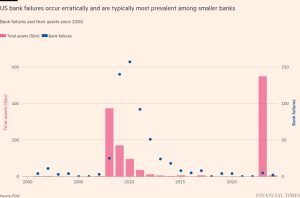Companies grapple with the ‘nature transition’ — but what does it mean?

This article is an on-site version of our Moral Money newsletter. Premium subscribers can sign up here to get the newsletter delivered three times a week. Standard subscribers can upgrade to Premium here, or explore all FT newsletters.
Visit our Moral Money hub for all the latest ESG news, opinion and analysis from around the FT
Hello again from the Colombian city of Cali, where the UN COP16 biodiversity summit is entering its second and final week. Tomorrow, two days of ministerial-level negotiations will begin to hammer out agreements on how to move towards the sweeping targets set two years ago in Montreal.
Thorny issues will include mobilising finance from both public and private sectors, and how companies in sectors such as biotechnology should compensate countries for the use of genetic information from their ecosystems. We’ll keep you updated.
This is the first of three UN environment COPs in quick succession. Next month comes the climate-focused COP29 in Azerbaijan. In December, Saudi Arabia will host another COP focused on desertification.
When we met in New York a few weeks ago, Christiana Figueres, former head of the UN climate change secretariat, railed against the international decision at Rio de Janeiro in 1992 to establish these three parallel processes. “From the eyes of nature, do you think that makes any sense?” she asked.
There are many who share Figueres’ frustration. On the other hand, this two-week event is forcing thousands of minds — including many from the private sector — to focus on nature and biodiversity issues that are sometimes neglected in the wider environmental discussion.
In today’s newsletter, we look at the latest work to help companies grapple with these challenges. First, read on for an exclusive interview with Astrid Schomaker, who is overseeing these talks as head of the UN biodiversity secretariat, and told me what she thought of the bumper business presence.
The impact investing sector has been growing, with fund launches from the biggest private equity firms — but it still accounts for a small portion of the asset management industry. Can it gain much greater scale — and can it achieve competitive returns alongside social and environmental benefits? That will be the subject of our next Moral Money Forum deep dive report, and we want to hear your views. Have your say here.
Cop16 Biodiversity summit
CBD head Astrid Schomaker: businesses aren’t in Cali just to lobby
The swollen guest list at COP16 — the busiest UN biodiversity summit so far, with 20,000 registered delegates, according to the Colombian hosts — is due in good part to the growing interest in these issues from multinational companies. Big business had a serious presence for the first time at COP15 in Montreal two years ago, and by all accounts is still more conspicuous in Cali.
This is good news, according to Astrid Schomaker, executive secretary of the Convention on Biological Diversity. The German former European Commission official, who was appointed in April, is tasked with co-ordinating the negotiations at COP16 and helping to shepherd nations towards an agreement.
“Those businesses who are here — it’s a bit different from the climate [COP],” Schomaker told me yesterday afternoon. “They’re not chiefly here to lobby.”
The “biodiversity community”, Schomaker added, “has been a very close, conservation-focused community . . . and has had little exposure to working with business. And business has, up to now, not shown huge interest in what was happening in the biodiversity space.”
That changed, Schomaker reckons, after the last biodiversity COP, which placed new emphasis on private-sector investment in this area, and on forcing corporate nature disclosures.

Still, there is concern among some here in Cali about corporate influence on discussions around “digital sequence information” — a niche but increasingly lucrative area, and a burning issue at these talks. The phrase refers to genetic data gathered from around the world by researchers and typically published on public, open-access databases.
Currently, companies — notably in pharmaceuticals and biotechnology — can use this data to make products without having to pay anything to the countries where the genetic material was found. Negotiators at COP16 are considering proposals for a levy on corporate income generated by using this type of data, with the proceeds going towards nature conservation. The global trade body for the pharmaceutical industry has expressed “serious concerns”.
“We’ve seen companies getting a bit more concerned [having] not really been very actively involved in this discussion in the past two years,” Schomaker said, noting that the Montreal pact in 2022 included an agreement in principle around fair sharing of benefits from genetic data.
“But there’s a number of companies that say: ‘Well, yes, I understand, and I want to be a good corporate citizen, and I want to make my contribution,’” she said.
NATURE-RELATED DISCLOSURES
Making sense of the corporate ‘nature transition’
For businesses genuinely seeking to play a constructive role in protecting nature and biodiversity (and even this jaded hack hopes that applies to a decent number of those represented in Cali), how to do so is far from obvious.
Establishing best practice in this area — or at least getting closer to that goal — is the objective of a paper published last night by the Taskforce on Nature-related Financial Disclosures. The paper from the TNFD — set up in 2021, steered by 40 members drawn from the executive ranks of global corporations and financial institutions — offers draft guidance to companies on how to develop “nature transition plans”. It’s out for consultation over the next three months, ahead of formal guidance to be issued next year.
Some executives may well groan on being presented with this concept, having already been pushed to provide climate disclosures and transition plans. But Emily McKenzie, the TNFD’s technical director, said the additional work was needed because most corporate climate plans to date had not given sufficient attention to companies’ nature-related risks, impacts and dependencies — which could range from water usage to deforestation in supply chains.
“We started where we started,” she told me. “So an organisation that already has a climate plan in place might find it more practical, at least initially, to develop a separate nature plan and then move towards integration over time.”
The TNFD — which followed the model set by the Taskforce on Climate-related Financial Disclosures spearheaded by ex-Bank of England governor Mark Carney — has been making progress on adoption. On Friday it announced that 502 global companies and financial institutions had now committed to reporting under its framework, up 57 per cent since January. The 129 financial institutions manage or control assets worth $17.7tn, it said.
Perhaps so as not to scare off potential future joiners, the new guidance stresses that companies can take an incremental approach to introducing a nature transition plan — starting with the simpler areas and tackling the more complex ones later.
But what does a “nature transition” actually mean? Climate transition plans broadly relate to the shift to a low-carbon economy, as well as managing the physical impacts of climate change. Nature transition plans relate to . . . what exactly?
According to the TNFD, the answer was provided at COP15 in 2022, where nations agreed on a sweeping set of objectives in a document called the Global Biodiversity Framework — essentially, the biodiversity equivalent of the 2015 Paris Agreement on climate change.

Among the 23 targets in the GBF are to restore 30 per cent of the world’s degraded ecosystems by 2030, and to mobilise an annual $200bn in funding for biodiversity strategies by the same date.
The TNFD guidance says that corporate nature transition plans should be focused on the company’s contribution to the global goals established in the GBF. Notably, it presents nature-related risk management plans — like buying insurance, or reducing exposure to potential problems — as a secondary objective, saying these should be “considered only as complements to the plans for driving real economy change”.
This is a gutsy approach at a time when many companies, especially in the US, are retreating from efforts to push for a greener world economy, amid conservative political complaints about “woke capitalism” and conflicts with fiduciary duty.
McKenzie said that the TNFD’s broader guidance invites companies to report on “material” matters, meaning they are free to omit aspects they did not consider significant to their business. Still, it will be interesting to see whether the primacy of “driving real economy change” survives in next year’s final paper.
It’s important to remember that the TNFD is essentially a business-led organisation. While it has a full-time secretariat and has consulted extensively with a wide range of stakeholders, all of its official members are from the corporate and financial sectors. And although it has enjoyed strong backing from bodies such as the World Wildlife Fund and the UN Environment Programme, other environmental groups have been far more critical.
Last week, a group of non-profit organisations, including the Rainforest Action Network and Friends of the Earth International, wrote to UNEP accusing it of “undermining the basic principles of fair governance” by supporting the TNFD despite the organisation’s failure to include members from outside business and finance. The non-profits also claimed that several of the TNFD’s members were employed by “corporations facing allegations of serious environmental or human rights concerns”.
UNEP said it was “fully committed to championing the rights of environmental defenders and to working with all stakeholders” to achieve the GBF targets, adding that these goals required a “whole-of-society-approach” including the private sector.
The TNFD said that it had engaged heavily with indigenous groups and civil society organisations, whose input had “meaningfully shaped” its recommendations.
As I’ve argued before, issues of representation mean that TNFD guidelines should not be seen as a blueprint for disclosure regulations to be imposed by governments. As part of a business-led effort to explore what best practice could look like, however, they are clearly a useful contribution to the literature.
Smart reads
Climate caution BlackRock chief executive Larry Fink has gone conspicuously quiet on climate, not uttering the word once on an analyst call since January.
Hydrogen downturn The valuations of listed companies focused on clean hydrogen have plunged on both sides of the Atlantic this year.
Gas deal falls through The European gas industry has rejected an agreement on retraining workers as part of the clean energy transition.
Droughts worsen Large-scale fires have hit the Amazon basin and the region’s hydropower-heavy electricity grids are struggling amid major droughts linked to climate change.
Recommended newsletters for you
FT Asset Management — The inside story on the movers and shakers behind a multitrillion-dollar industry. Sign up here
Energy Source — Essential energy news, analysis and insider intelligence. Sign up here
#Companies #grapple #nature #transition




